Litepaper
DATE: Month of Mars, Ides, 2022 – Imperial Date PWG
SUBJECT: Crypto Colosseum Decomposition Report
COMMANDER: Imperator General Krav Lagrav
REPORTING AGENT: Imperator Hrul Hrang
As ordered by Imperator General Krav Lagrav, I, Hrul Hrang of the Kegel Rippers, will provide a basic analysis of the all-important Crypto Colosseum. This analysis will describe its evolving structure, combat fundamentals, and its crypto-financial underpinnings.
The competitions within the Crypto Colosseum are increasing in importance across the Crypto-Roman Empire. Although the sacred blockchain underwriting prevents direct manipulation, the Emperor wishes to exert greater influence. Power over the Colosseum is control of the Crypto-Roman world.
It poses a moral question, “How far should we go in order to maintain dominance?” Counter-DAOs are flourishing, and Wootgump ($SKALE) continues to enter the world, upsetting the natural Imperial Order.
The Emperor will have to vie with powerful patrons from across the empire to control the underlying assets. This report provides a base understanding in order to inform the Imperator’s future plans.
All Hail the Emperor! All Hail the Imperium!
BACKGROUND:
The battles of the Colosseum date back to the imperial date of 1000 Post Wootgump (PW). The Technology Innovation and Equivocation Act was passed in 2020 PW by his Most Worshipful Majesty BAYC Magnus IV, who ordered Lucertia Lagrav to start the development of what became the Colosseum.
Nearly a millennium ago, the crypto roman bio-consensarri found a vein of $SKALE that seeps up through the northern pole. This miraculous substance bubbles to the surface, and, in the frigid, desolate Arctic, the Wootgump plant grows. These magical plants, in turn, allow a jungle to flourish in the bitter cold. The Wootgump plant seethes with psycho-active nanoparticles that heal everything around them, even death itself.
The discovery and control of Wootgump ($SKALE) in the far North triggered a rush for control as well as a crescendo in the scale, scope, and importance of the great Colosseum.
PATRONS (PLAYERS)
Patrons are the lifeblood of Crypto Rome, constantly vying for $PRESTIGE in the great arena.
First, patrons can simply back their favorite gladiators and tournaments, putting their $PRESTIGE on the line. This is the way many of today’s wealthiest patrons got their start and is a favorite among both the rich and poor.
As a patron climbs in rank, they acquire $RECRUITS to their cause. If they are wealthy enough, they develop both warriors and crafters and put them to work, earning their patron ever more prestige.
As patrons continue to become more sophisticated in the ways of the crypto-gladiatorial complex, they hire $RECRUITS. Both crafters (creating magnificent $ARTIFACTS) and warriors that fight for glory and wootgump have their place on the path to success. Patrons pick out the most talented among their forces and put them to profitable work or simply sell their contracts on to others.
Crafter $RECRUITS work the great $FORGES producing $BOONS and $ARTIFACTS. $BOONS are sold during arena matches, but $ARTIFACTS are assigned to warriors by the warrior’s patron. $ARTIFACTS are also traded in the marketplaces of Crypto Rome.
Warrior $RECRUITS quest in the Arctic Jungles as part of a Warband: collecting the valuable Wootgump and searching for valuable $RELICS while absorbing the ambient Wootgump and mastering the art of bloody combat.
A select few patrons acquire the greatest warrior $RECRUIT talents and develop them as gladiators ascending to fight in the epic battles of the Colosseum. They vie for individual and team championships at the highest levels and win acclaim and fortunes.
As a gladiator progresses, the patron must oversee (and finance) the gladiator's training, outfit them with powerful $ARTIFACTS and work the crowd to support their champion. If the gladiator progresses to the Emperor's League, the pinnacle of the Colosseum, their earnings are truly epic. A promising gladiator can earn a massive amount of $PRESTIGE for their patrons.
More detail on the mechanics of gladiator battles follows later in this report.
Fundamentals of Prestige
The Colosseum’s core financial loop centers on $PRESTIGE. Back the right gladiators, and your reputation grows. Back the wrong ones, and your reputation is diminished.
$PRESTIGE represents a Patron's essential reputation. It can be spent to enhance their position, help their sponsored gladiators win, or even traded for other resources to improve their gladiatorial empire with $RELICS, $ARTIFACTS, and $BOONS. Wise patrons use their $PRESTIGE to build more ways for them to earn and win, creating a virtuous cycle of ever-growing riches.

COMBAT
- Most important factor is gladiator’s raw physical talent and capabilities
- Attack, Defense, Speed, Health, Pop
- Abilities can be increased, but raw talent provides a critical base
- Skills are increased by training.
- Stronger gladiators train weaker ones, and need to spend time and coin to do so.
- Neither teacher nor student can participate in lucrative tournaments during training time.
- Training happens in a Ludus which has its own attributes and features
- Natural talent is supplemented with a few things:
- Artifacts
- Long lasting equipment, transferred between gladiators
- Over time, artifacts can breakdown, but wootgump can fix them.
- Boons
- Single use items are offered for sale to the crowd during battles
- The crowd uses these to help their favorites
- Some items power particular moves; some heal; others cancel an opponent's advantage
- Secondary to boons, cheering can also affect the outcome of a battle
- Artifacts
The most important single factor in battle is the gladiator's raw talent: their ability to take the initiative from their opponent, attack them effectively, and defend themselves when necessary. These abilities are increased in several ways, but all methods build on a warrior’s innate talent.
These baseline abilities are increased through training. A gladiator with greater abilities can spend time and energy (via $SKALE/$PTG) to improve the abilities and skills of an understudy. Neither can participate in tournaments during this time, so it represents a true investment into the gladiator's career. These training sessions happen at Gladiatorial $LUDI (training schools). These special training schools have their own unique features that can enhance training and potentially reduce the times necessary to perform them. More on these can be found in the follow-up section detailing $LUDI, artifacts that impact them, and their unique features.
Natural talent is supplemented with two different types of objects that have absorbed the power of the Wootgump. The first type is $ARTIFACTS. $ARTIFACTS are long-lasting equipment that can be transferred between gladiators by the patrons who sponsor them. There is a limited amount of equipment that any single gladiator can equip. $ARTIFACTS enhance the natural talents of the gladiator. Gladiators need to be attuned to their $ARTIFACTS and practice with them for a time to become proficient in their use. Similar to training, this attunement process can be enhanced at a well-provisioned $LUDUS.
There is always a chance, however unlikely, that an $ARTIFACT’s essence can be shattered during battle. The $ARTIFACTS can often be recovered if placed in a high Wootgump environment under the care of a skilled crafter.
The second material-based enhancement happens with more common and transitory Wootgump infused objects referred to as $BOONS. These items are single-use and are for sale DURING battles. As part of the entertainment, members of the crowd are offered the opportunity to buy items and toss them to their favored gladiator. These real-time items have a profound effect on the results. Some items power particular moves; others provide an infusion of wootgump to heal the combatant; others simply cancel an advantage an opponent might have. Their use is a strategic consideration but not just the responsibility of the patron but of the wider crowd.
Often networks of fans are coordinated during battles to optimize the $BOONS that are provided during a battle. Patrons network with and potentially fund key members of the crowd to coordinate this activity. Much $PRESTIGE can be won or lost based on these decisions. The source and costs of these items will be covered in the financial section below.
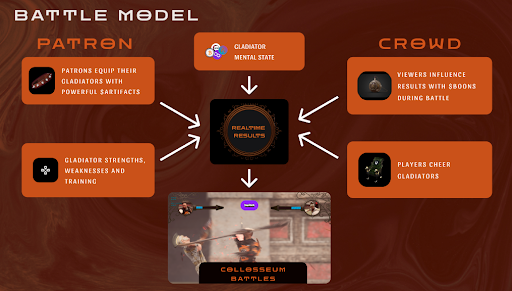
The last significant factor in determining the winner of gladiatorial combat, and thus critical tournaments, is the crowd themselves. The bodies of gladiators become permanently bonded to wootgump. The residual particles retain their psychoactive properties and they respond with a trickle of energy to the strong emotions of the crowd. If the crowd cheers for a favorite, that energy and adoration infuses the gladiator and enhances their powers. The cheering crowd directly impacts the outcomes.
There is a belief among many of the bio-censarii that the mental state of the gladiators has a direct impact on outcomes as well. In particular pre-combat interviews with fans and the media right before a contest are deemed critical. Is it better to rile them up or calm them to improve focus? More information on this aspect of the battles in the Crypto Colosseum is to come.
Acquiring Assets in the Crypto-Roman World
Masks
- Masks of Revelation are converted into $RECRUITS, $ARTIFACTS and $RECIPES at special ritual circles
- The mask is consumed and a new NFT is minted to the Patron through the Ritual of Revelation
- There is a special gateway for each tribe which is made available through periodic releases
Patrons acquire $RECRUITS, $ARTIFACTS and $RECIPES through the open market, a warband discovery or through the Ritual of Revelation. If the Patron has been lucky enough to secure one or more Masks of Revelation, they can conduct a ritual in one of the Ritual Gateways. The patron calls forth powerful beings and objects by donning their mask and invoking a ritual call to the pantheon of crypto deities.
Masks of Revelation will be released over time (details in the Roadmap in Appendix 2) along with new gateways and available through special auctions. The initial release includes the Retro-Vikings of the Arctic Jungle and the Legionaries of the Imperial Capital. The Children of Moloch of the Burning Steppes, the Knights of the Iron Kingdoms and the Ronin of the DAO Prefectures follow.
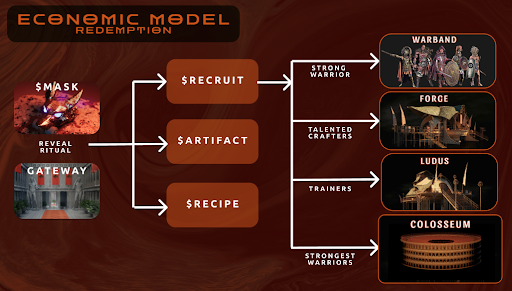
The genesis mask release is uniquely guaranteed to reveal only rare and ultra-rare NFTs of each type. Progressive releases will have a chance to call forth not just rare and ultra-rare, but uncommon and common items as well.
The Mask of Revelation expends all of its wootgump power when the mask is donned and the ritual performed. Patrons need to choose their gateways carefully. Ritual gateways reflect not just the aesthetics of the entity called forth, but influence the talent or $RECRUITS, the abilities of particular artifacts, and the types of recipes.
$Recruits and new Gladiators
- $RECRUITS are up-and-coming talent
- Not all become successful gladiators, some are better suited to crafting or joining warbands
- Once a gladiator has successfully survived the trial of the gladiator they, with the coordination and financing of their patron, join a Ludus, receive training, and are outfitted with $ARTIFACTS.
$RECRUITS are the raw, the up-and-coming, the untapped potential for greatness.
Not all recruits make it to the exalted status of a gladiator and compete in the Crypto Colosseum. They need to be tested.
Some will have what it takes to be a warrior, others, however strong, are better suited to the forge and the creation of new items and artifacts. These builders and creators are called crafters and beyond their overall skill level (rarity) they have specialized abilities which speed up or improve the properties of particular boons and artifacts to which they have an affinity.
There are many different ways for the ambitious to get ahead. $RECRUITS that take the warrior's path will need to pass through the trial of the gladiator before they can be trained and fight in the arena. Wootgump is injected into their systems. Some thrive and go on to become gladiators; others reject the powerful elixir and fail to progress.
Those warriors that fail to qualify as gladiators take time to recover. They often fight in Warbands, exposing themselves to the jungles of wootgump before they again attempt the crucible of the gladiator's path.
Once a gladiator has successfully survived the trial of the gladiator’s path, they are qualified to battle in the arena. To be successful, however, they will need the assistance and financing of their patron. They can join a Ludus, receive training, and if available receive an artifact to help them on their way.
Then it is time to face their opponents in the ARENA!
Those warriors that don’t make it as gladiators or even gladiators that are not actively in the ring are sent in warbands to the arctic jungles of the north to fight for the Wootgump that fuels the entire Arena ecosystem. While questing for Wootgump they may also recover $RELICS to help their patron build their empire.
As a gladiator becomes more experienced, they have the option to work as trainers. They put their skills to work, helping less experienced gladiators learn the bloody trade of fighting in the arena. They may even learn a new trick or two themselves through the arduous process.
As gladiators battle and gain experience, they become more powerful but also recover just a little slower between battles. They and their patron need to carefully consider when and where to fight. Should they fight relentlessly, continuing to gain skills and prestige, or conserve their energy for only the most epic tournaments and league championships?
PLAYING TO EARN
- Patrons (Players) can earn in a variety of ways including:
- Putting their $PRESTIGE on the line, backing gladiators to win
- Arming warbands and sending them to the Arctic Jungle to fight for Wootgump and $RELICS
- Helping their gladiators win prize $PTG in the arena
- Creating and then selling $BOONS or $ARTIFACTS with a $FORGE
- Earn fees training other patron’s $GLADIATORS in their $LUDUS
- Joining a consortium to build a new $COLOSSEUM
Success in many aspects of the arena is based on controlling the resources that fuel it. Many of these resources are derived from Wootgump and other interworld resources filtering into the Crypto-Roman world. Wootgump itself can be traded for the PRESTIGE ($PTG) that backs the fame and reputation of all of the players in the Colosseum ecosystem.
There are a variety of ways to earn in the game from the very casual to more advanced options.
The most basic technique is to passively put assets ($RECRUITS, $ARTIFACTS and $RELICS) to work in warbands fighting in the Arctic Jungles. These warriors and tools are all staked in a group and sent to the far North.
They compete with other warbands which battle for Wootgump on week-long missions. A combination of their fighting prowess and luck determines what share of the Wootgump rewards filtering through the Arctic Jungle each warband (and their patron) receives. In addition to the Wootgump warbands collect, there is a chance that they come across rare $RELICS in their searches. These treasures have unique properties and are used in the creation of $ARTIFACTS as well as the founding of new buildings such as $FORGES and $LUDI. More information on each of those in later sections.
Once a patron has a talented warrior who has qualified to fight in the arena (a gladiator) they have the chance to pit them against others in bloody battles. The battles can be in one-on-one challenge matches or more elaborate scheduled tournaments. Winning battles helps strengthen the gladiator through experience as well as earns their patron more $PRESTIGE if they win. As the challenge of the battle increases, the rewards and engagement needed to win increase in kind.
Another way to play-to-earn is in the creation of $BOONS (single-use items available during a match) or $ARTIFACTS, to arm gladiators, in a $FORGE. Staffing a $FORGE with talented crafters and securing rare and powerful $RECIPES ears the patron more $PRESTIGE.
Founding or joining a $LUDUS also represents a chance for a wise patron to profit. Set up a school, put your most talented $GLADIATORs to work training others, and charge for the privilege.
WARBANDS
- Stake $RECRUIT and $ARTIFACT NFTs to pursue missions in the Arctic Jungle
- Warbands can find $PTG and $RELICS, $ARTIFACTS or even $RECIPES
- The stronger your staked NFTs, the greater rewards you will find and the better your chance of holding on to them
- Successful gladiators that are not actively fighting matches in the arena can be used as champions to lead warbands.
- Warbands compete for a set supply of Wootgump emerging each day, but more warbands competing increases the chances for other treasures.
The arctic jungles of the far North are inhospitable and dangerous in the extreme. Wootgump filters up to the surface allowing the jungle and its many strange flora and fauna to thrive and compete.
Powerful patrons send groups of warriors (warbands) to secure both Wootgump and $RELICS. In rare cases, these warbands find $RECIPES for the creation of new $ARTIFACTS and $BOONS..
The great healing, provided by wootgump, is foundational to the empire itself. $RELICS are ancient cross-world treasures infused with Wootgump. $RELICS have unique properties and are key to building the best Ludi and the most powerful Forges.
A warband must be dedicated to their mission. They are unavailable for other pursuits (staked) and can perform no other tasks between two days and two weeks (at the patron’s choice). The longer missions increase the chances for rarer rewards but they also increase the risks.
The discovery of the emergent Wootgump site is what all warbands seek but they are not alone. With each discovery there is a good chance of encountering another warband also drawn to the area. The bigger the prize the bigger the chance it will be a fight to secure the discovery.
When two warbands come across the same discovery, they battle each other and the stronger and more determined force prevails. The stronger your warband, the better your odds of coming away with the prize! In rare cases a Warband that is soundly defeated may not just lose out on the new discovery, but potentially the booty (Wootgump, $RELICS or $RECIPES) from early encounters as well!
Patrons can check on their warbands results each day but can not collect the earned rewards until the Warband returns from its mission.
The number of warbands and their strength guide the rewards available. The stronger and more numerous the warbands, the more they must fight over the available Wootgump supply. Although the amount of Wootgump is fixed during any single mission (described in appendix one) the chance for exceptional treasures like $ARTIFACTS or $RELICS increases with the number of active Warbands.
LUDUS
- A Ludus is a specialized school for gladiators.
- One or more patrons collect the necessary $SKALE and $RELICS to form the foundation.
- Ludi can be improved (3 levels) over time to be more effective for training and to speed the process up.
- There are several unique artifacts that can provide special skill transfers during training
- Gladiators train together, stronger gladiators improve weaker gladiators
- Small amounts of Wootgump are consumed by the training process
- Only a small number of gladiators may train at a time, and this process takes very rare resources to build and upgrade a $LUDUS.
A Ludus is a specialized school for gladiators. One or more patrons collect the necessary Wootgump and $RELICS to form the foundation. Ludi can be improved (3 levels) over time to be more effective for training and to speed up the process. There are also several unique $ARTIFACTS that can provide other special skill transfers during training.
Gladiators that train within a $LUDUS gain unique benefits well beyond what is possible with normal training. They train together in pairs for hours and days at a time. Based on the research of the bio-censarii, it appears the wootgump particles that permeate their bodies become attuned. The nanoparticles learn from each other during this process. This transfer allows core capabilities to improve with the stronger, faster, more dexterous party imbuing some of their powers into the less capable gladiator. This process consumes a certain amount of wootgump.
Only a small number of gladiators may train at a time and it takes rare resources to build and upgrade ludi.
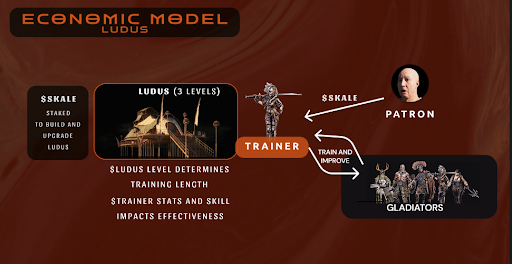
Some existing ludi are available for a fee to train those outside the circle of patrons that founded the school. As a patron’s warbands continue to collect $RELICS and invest them into improving their $LUDI patrons can take advantage of this method of supplemental training.
FORGE
- Associated with a particular $COLOSSEUM
- Founded by patrons by staking $PTG and $RELICS
- Artifacts created in the forge can be used in any colosseum
- $BOONS can be used only in the colosseum in which they were forged.
- Crafters ($RECRUITS) run a forge
- have different talents that qualify them to build certain objects
- Only the most talented crafters can make $ARTIFACTS
- Speed of creation is based on:
- Level of the $FORGE
- Quality of the $RECRUITS crafting skills
- $RECIPES are required to create the more rare $BOONS and $ARTIFACTS
One or more $FORGEs can be associated with a particular Colosseum. Like a Ludus, they are founded by an enterprising patron, or group of patrons, staking their $PTG and $RELICS to build them. These great workshops and smithys run day and night, churning out valuable constructs at their patron's command.
The $ARTIFACTS (permanent equipment used by gladiators) created in a forge can be used in any Colosseum. The $BOONS that fuel the real-time battles can only be used in the Colosseum with which the forge is associated. $BOONS are inexpensive to make and are then sold into pools available for purchase during arena bouts. They provide a steady stream of income. $BOONS are consumed (burned) in battle.
Crafters ($RECRUITS with appropriate crafting skills) are required to run a forge and their talents affect how well they work. Some specialize in laboratory work such as the creation of potions or oils, others creating weapons or armor. Some work Wootgump into single-use $BOONS. The most talented help create new $ARTIFACTS though these often take significant time and require other resources.
The speed and resources needed to create $ARTIFACTS are based on a combination of the level of the forge (there are three levels of forges known to exist) and the quality of the crafters working in it. Raising the level of a forge creates more room for skilled crafters to do their work. Founding or upgrading a forge with very specific $RELICS is also known to increase its efficiency or qualify it for the highest level of crafting.
To build $BOONS or $ARTIFACTS, a $FORGE needs to deploy $RECIPES. Some of these, are easy to come by. Others are quite rare and require blood and luck fighting with a warband.
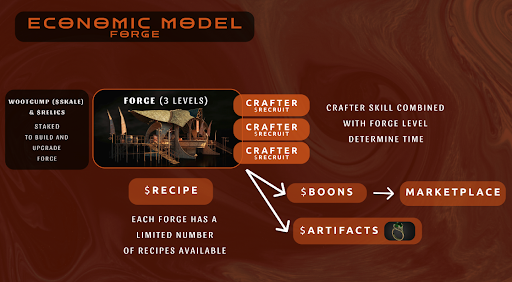
COLOSSEUM
- The big deal
- Patrons cheer/back gladiators during the battles that take place within them
- Colosseum owners get a cut of most transactions occurring in their arena
- Only 2 Colosseums at launch, but patrons will found more in the future
- Colosseums host on-demand battles between gladiators and their patrons. The wealth behind the Colosseum provides part of the prize, as do the fight fees pledged by each patron.
- The crowd puts their prestige on the line, items flow and a victor is crowned.
The Colosseum is the great battleground. The center of the Crypto-Roman world.
Fundamentally, each Colosseum represents an ecosystem of gladiators and their patrons. Each Colosseum can have several forges that manufacture the $BOONS used within it. Each Colosseum is also associated with one or more Ludi which compete and at which gladiators train to improve their skills.
The patrons bring their best gladiators, the crowd builds their prestige by picking the winners, and through their cheering and deployment of $BOONS help strategically shape who wins and who loses. Gladiators and Ludi rise and fall on not just their own strength but the brilliance of their patrons and the will of the crowd.
Similar to a $LUDUS, there can be multiple $COLOSSEUMS. Today there are only two. One for the Emperor’s League and one for the Praetorian League. As the arena continues its ascent, others will certainly form across the empire.
If powerful patrons can collect the needed $RELICS and $SKALE, new Colosseums can and will emerge in the future.
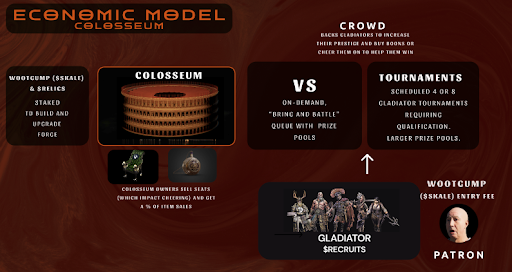
Colosseums host on-demand battles between gladiators and their patrons whenever two foes are ready to battle. The prizes for these battles are fueled by entry fees and the wealth of the Colosseum itself. The crowd puts their prestige on the line, items flow and a victor is crowned.
When Colosseums evolve to a sufficient level, weekly tournaments and seasons come into play. These pit groups of patrons against each other, putting more on the line for even greater rewards.
Leagues
- Leagues are associated with specific Colosseums
- Different tiers of leagues get different prizes
- Ludus compete against each other over the course of a season
- Gladiators level up during seasons (as well as generate tokens for patrons)
Leagues form around particular Colosseums. The greatest of these is the Emperors League. Weekly and monthly special tournaments offer huge opportunities for patrons to put their prestige on the line. Not only the patrons but the gladiators themselves benefit from winning these bigger tournaments.
Beyond tournaments for strong performances in a week or a month, the $LUDI compete with each other over the course of seasons. These seasons climax in playoffs which pit the champions of each Ludus against each other. The rewards for these tournaments are beyond individual rewards and can even promote the improvement of the Ludus itself, leading to a virtuous cycle within the top schools of the empire.
CONCLUSION: \
The Emperor currently controls the great Colosseums but preventing patrons from founding their own will only create unrest among the most powerful in the empire. Pitting patrons against each other in competition at every level will keep the Emperor transcendent.
APPENDIX ONE - SUSTAINABLE GROWTH and FUNDING
Crypto Colosseum is built on a sustainable economic foundation. There is a fund of $SKALE that will never be consumed and will only grow over time. This primary fund is staked, to help secure the network and all of the generated funds fuel rewards. Purchases of game assets further grow the principal pool.
The rewards from the staked $SKALE principal pool are put into the prize pool and paired to a matching amount of prestige ($PTG) in the game. 30% of those $PTG rewards are part of the payout for warbands competing in the Artic Jungles. 60% of those rewards are used to incentivize the tournaments for both backers and as prizes for the winning gladiators. The last 10% helps fund further development of the game and new asset types.
It is worth noting that by holding $PTG you are esentially holding staked $SKALE and helping to secure the network.
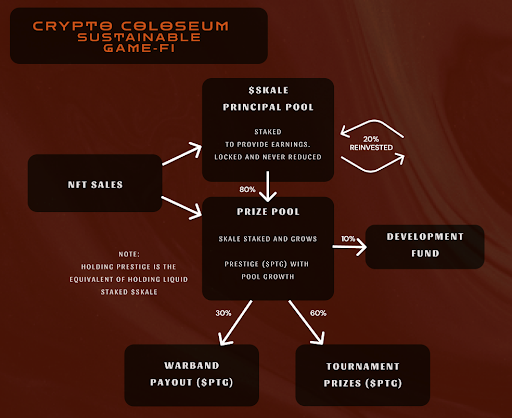
APPENDIX TWO - CRYPTO COLOSSEUM ROADMAP
Crypto Colosseum has a series of releases planned for each of the coming quarters. Each quarter, new game functionality comes online and new tribes and assets are released.
The genesis release is 1111 Genesis Masks which help fund future development efforts. 50 genesis masks will be distributed to the patrons of the earlier version of Crypto Colosseum which was used to verify gameplay and key dynamics.
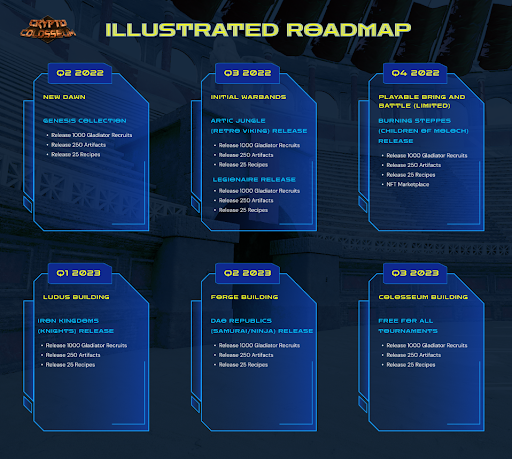
Each mask represents a game asset revealed in a ritual circle when a patron (player) uses it. The ritual circle used to reveal the asset will impact the visual elements and some details associated with the $RECRUIT, $ARTIFACT or $RECIPE that emerges. As each new ritual circle is available, masks from any release can be used at that ritual circle.
Genesis masks are guaranteed to be RARES or ULTRA-RARES which means all warrior recruits revealed will be strong enough to be successful gladiators fighting in the arena if they receive the right support. In no other phase of release will this be true.
The first quarterly release will be the first two ritual circles and associated tribes: the Arctic Jungle, revealing Retro-Vikings and the Imperial Capital, revealing Legionnaires.
Each quarterly release will include new ritual circles as depicted in the visual roadmap and will include the Children of Moloch of the Burning Steppe, the Knights of the Iron Kingdoms and the Ronin of the DAO Prefectures.
Each release also brings new functionality to the game as enumerated in the roadmap. First warbands will be available and earning shares of the prize pool of Wootgump and other rewards can begin. Then the Colosseum will open for patrons to bring the strongest of their warrior recruits, their elite gladiators, to battle.
Later comes tournaments, new buildings and eventually the ability for whole new Colosseums and leagues to form.
APPENDIX THREE - Glossary
Wootgump
The powerful psycho-reactive nanoparticles that filter up through the Arctic Jungle and power the crypto Roman world.
$PRESTIGE
The powerful psycho-reactive nanoparticles that filter up through the Arctic Jungle and power the crypto Roman world.
$BOONS
Single use objects that the crowd can buy during a battle and which will help the gladiator for which it was purchased. They are created in $FORGES
$ARTIFACTS
$ARTIFACTS are powerful items of equipment which can be assigned to gladiators and which provide significant benefits in combat. They persist between battles.
$RELICS
$RELICS are rare cross-world assets imbued with wootgump that are needed to create or upgrade new buildings such as $LUDI or $FORGES or $COLOSSEUMS. They are also required for some rare $ARTIFACT recipes.
$RECRUITS
$RECRUITS work for patrons pursuing their goals. There are $RECRUITS that act as crafters working in forges, $RECRUITS that act as warriors fighting in Warbands and the strongest of $RECRUITS that fight as warriors within the arena.
$RECIPES
$RECIPES are employed in forges to enable the creation of $BOONS or $ARTIFACTS.
$LUDUS
A $LUDUS is a gladiator training school. They also act as “teams” for seasons and tournaments, enabling collaboration between patrons.
$FORGE
Crafter $RECRUITS work at $FORGES to create $ARTIFACTS and $BOONS.
$COLOSSEUM
$COLOSSEUMS are where gladiators battle for glory. Each $COLOSSEUM has a league and a set of $FORGES and $LUDI associated with it.